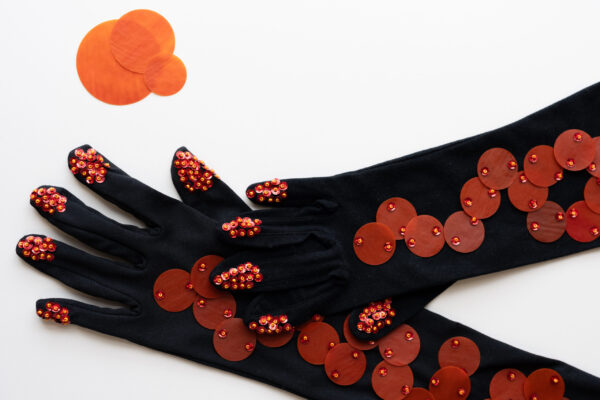AUSTIN, Texas — Although many visitors to Texas Science & Natural History Museum are familiar with exhibits featuring towering fossils of dinosaurs from millions of years ago, the museum’s newest exhibition is all about sustainability for the future.
Each year, the fashion industry produces plastics for the manufacture of synthetic materials, using the equivalent of 300 million bathtubs of petroleum in the process. To advance a vision of a cleaner, brighter future for the industry, the multi-hued new addition, “Particles of Color: Where Science Meets Fashion,” explores the use of compostable, plant-based and biodegradable materials in clothing, accessories, jewelry and art.
University of Texas at Austin faculty members, students, researchers and alumni of the Division of Textiles and Apparel combined their fashion design know-how with expertise from materials researchers to show how newly developed sustainable sequins can be used across a wide range of artistic creations.
“The fashion industry is a huge contributor to plastic pollution,” said Jessica Ciarla, a faculty member in the Division of Textiles and Apparel who is behind the exhibition. “We wanted to show that there is a way to create something better with the materials we have right now.”
The exhibition features more than 50 glittering objects made with a compostable material, called polylactic acid, that has been combined with natural and nontoxic dyes to create colorful high-fashion clothes, jewelry and art. Polylactic acid is made from agricultural waste and is easy to work with, Ciarla said. It is practical for use in fashion because it does not dissolve in water, but it will break down if composted.
The UT research on sustainable sequins originated five years ago with a President’s Award for Global Learning to Ciarla; Nathaniel Lynd, an associate professor in the McKetta Department of Chemical Engineering; and Luisa Gil Fandino, an associate professor of textiles and apparel.
Now, visitors to the exhibition can learn how the UT researchers adapted the material for use in fashion and enjoy opportunities to see the work of designers, from Austin to New York, who were recruited to create pieces incorporating the innovative material.
The installation is the first new exhibition at Texas Science & Natural History Museum since it reopened in September 2023 after an 18-month closure and extensive renovation. The fourth floor of the museum has been designated the Science Frontiers Gallery and is designed to house exhibits on advanced scientific research and demonstrate how scientific discovery can help address issues and concerns of our own time.
“Visitors of all ages can explore how research happening right here on the UT Austin campus can make an impact on the natural world by creating compostable materials used in clothing we all can wear,” said Carolyn Connerat, the museum’s director.




